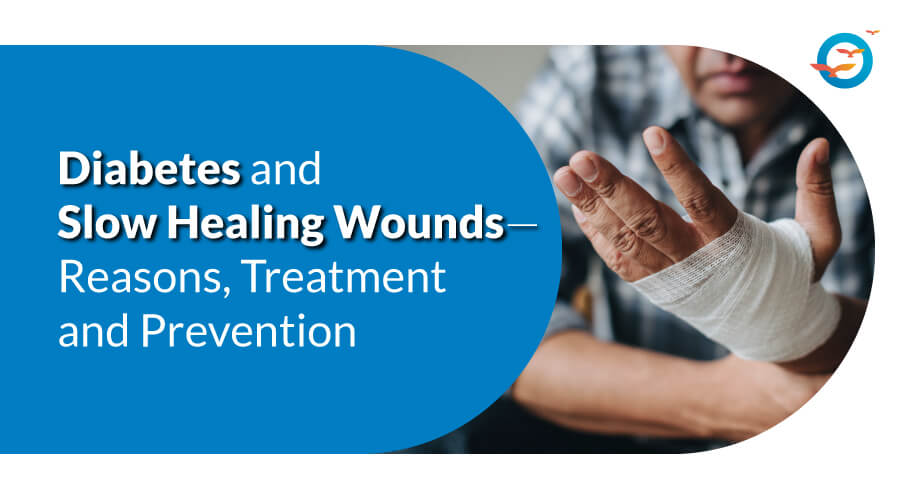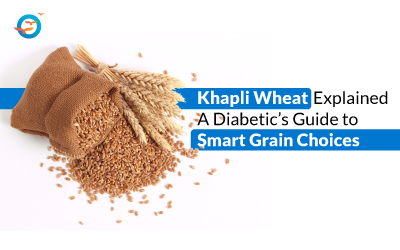Diabetes and wound healing: Reasons, Treatment and Prevention

One of the basic symptoms that characterize diabetes is the slowing down of the body’s healing process. Even a small scratch or blister can turn into an ulcerous wound. This can happen anywhere on the body, though the feet are the most commonly affected. Read to understand why this happens and what you can do about it.
Diabetes is a chronic disease brought about by insulin resistance. This is a condition caused by the body’s inability to use the insulin produced by the pancreas, so insufficient insulin production. As a result, glucose absorbed from the food you eat cannot reach the cells where they are needed to create energy. Instead, the glucose accumulates in the bloodstream, where, if left untreated, it causes havoc to almost every organ and system in the body.
Reasons for slow wound healing
Diabetes compromises your body’s self-healing capacity, there are three primary reasons for this:
1. Insufficient nutrients and oxygen reaching cells
High Blood Sugar Levels (BSL) increase the thickness of blood cells, reducing blood flow, effectively reducing the volume of oxygen and nutrients from reaching the cells. This poor circulation often results in peripheral artery disease, wherein the blood vessels narrow, further affecting the circulation of red blood cells.
2. Compromised immune system
High BSL affects the immune system, reducing its ability to fight off bacterial infection. Worse, the high blood sugar feeds the harmful bacteria that begin to flourish, further aggravating the wound. If this situation continues, it will lead to further complications like sepsis—a life-threatening reaction to infection, or gangrene—when a part of the body dies because of infection or insufficient nutrition & oxygen.
3. Increased inflammation
There is a strong connection between diabetes and inflammation. This inflammation, which is worse in people suffering from obesity, has a direct impact on healing. If the BSL is not checked, this inflammation spreads to other parts of the body and begins to damage organ health.
Warning Signs
You know it’s time to visit the doctor if you notice any of the following signs, especially if the symptoms below last for longer than a week.
- Tingling/pins and needles
- Burning feeling
- No sensation in the area
- Persistent pain
- Swelling
It’s a good idea to consult your doctor if you notice a cut or bruise and you’re not sure about how to take care of it. Appropriate and early treatment will prevent complications.
Complications
Over time high BSL causes damage to nerves and blood vessels, which results in a loss of sensation. So, often patients are unaware that they even have a wound. This is a real concern for diabetics, as it can lead to serious complications, the most serious of which is amputation. Statistically, diabetics are 15 times more likely to require amputations, due to foot wounds or ulcers, than others.
Prevention & Treatment
There are some basic steps you can take to ensure you don’t suffer from long healing wounds.
-
Regular checks
Checking for wounds regularly is a basic preventive measure to avoid infections and complications. Make it a habit, by working it into your daily routine to check for any cuts and bruises, especially on your feet—this includes the often-ignored spaces between and under your toes.
-
Clean up dead skin
Necrosis, a condition characterized by excess dead cellular tissue, is a common occurrence with diabetic wounds. This dead tissue is a breeding ground for bacteria and toxins. It also hampers close inspection of the wound. Talk to your doctor or a medical professional to help with removing and cleaning up the dead skin.
-
Change dressings regularly
In the event that you do suffer from a wound that needs dressing, ensured that the dressing is changed as often as needed, to keep the wound clean and reduce bacteria. Ask your doctor for special wound care dressing for diabetic wounds
4. Rest the area
Overworking the area or putting pressure can worsen the wound or ulcer by increasing wear and tear to the area. Rest gives the body a chance to heal the wound.
-
Improve overall immunity and health
- Switch to a proper diabetic diet:
This means reducing or cutting out all simple carbs, fatty and fried foods, and increasing your intake of fresh greens, healthy beans, legumes, berries and other fiber-rich food. This will help you maintain a healthy blood sugar level and improve your healing capacity. Stop smoking and reduce or cut out alcohol intake too. - Exercise regularly:
Fitness is a key element in improving insulin sensitivity, try and get at least 30 min to an hour or exercise every day. Incorporate cardiovascular activity, resistance training and flexibility/balance movements - De-stress:
Stress is a major cause of chronic inflammation in the body, and it has a negative effect on BSL in general. Meditative practices like Prayamaya breathing, meditation or even gentle exercise like yoga or tai-chi have been shown to improve overall health and induce a general feeling of well-being.
Takeaway
In the end, the major cause of diabetic complications is high blood sugar itself. But you don’t have to continue to suffer from high BSL. FFD’s diabetes reversal program has helped tens of thousands of people across the world stop all their medicines and go on to live healthy diabetes-free lives. Visit us at www.freedomfromdiabetes.org/programs for more detailed information about our reversal programs.

